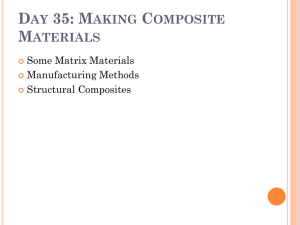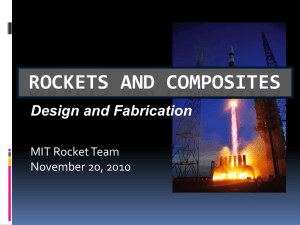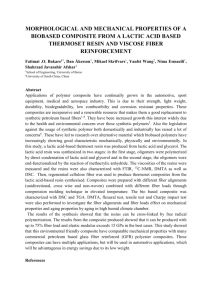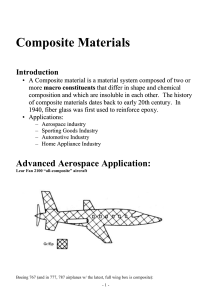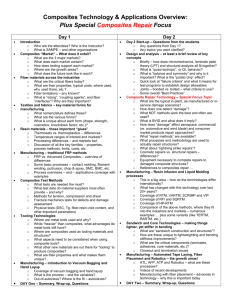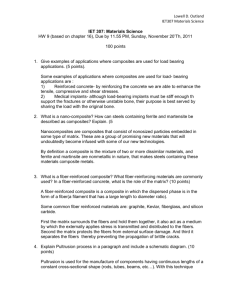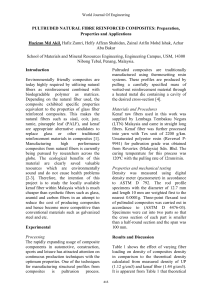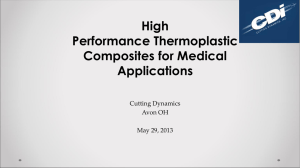History and Current Status of the Plastics Industry
advertisement
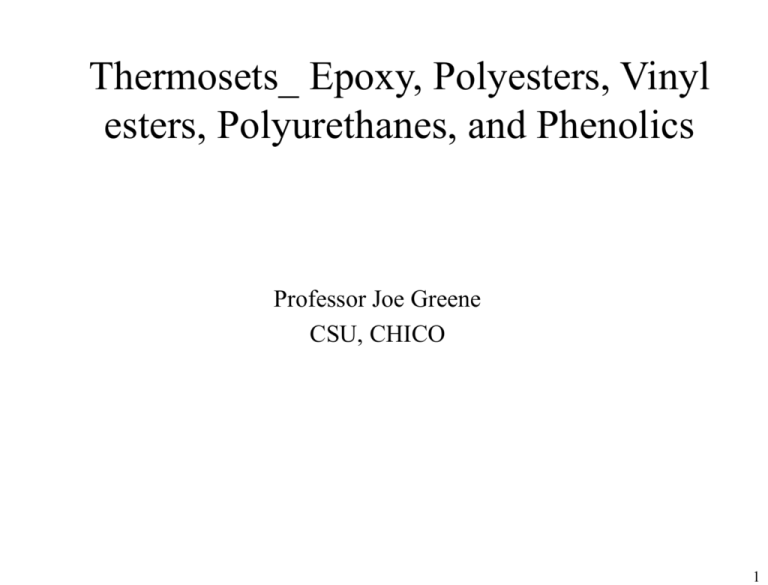
Thermosets_ Epoxy, Polyesters, Vinyl esters, Polyurethanes, and Phenolics Professor Joe Greene CSU, CHICO 1 Composites Reference: Appendix E. Industrial Plastics, Modern Plastics Encyclopedia (p142) • • • • • • • • • • History Applications Advantages/Disadvantages Chemistry and Chemical Structure Mechanical Properties Physical Properties Processing Characteristics Other thermosets Review Questions 2 Composites History • Thermosets are polymers that undergo a chemical reaction during the polymerization. • Thermosetting reaction is not reversible under heat. • Epoxy – Standard epoxy is based on bisphenol A and epichlorohydrin. – Others based on phenols and formaldehyde or aromatic amines and aminophenols – Curing can occur at room temperature with the use of 2 component systems. Curing at elevated temperature with use of one-component. – Properties include good adhesion to many substrates, low shrinkage, high electrical resistivity, good corrosion resistance, and thermal. – Processing is achieved without generation of volatiles. 3 Polymers Composites • Objectives – Define the components and difference types of composites. – Explain the different types of composite construction and the reasons behind them. – Describe the various manufacturing methods used to produce composites. – List the different reinforcing materials used in composites. – List the various matrix materials used in composites. • Excellent Web sites – Michigan State http://islnotes.cps.msu.edu/trp/ – U of Delaware http://www.ccm.udel.edu/publications/CU/99/ – Cornell University http://www.engr.siu.edu/staff2/abrate/NSFATE/links.htm 4 Composites • Composite definition – A composite is a material comprised of two or more physically distinct materials with at least one material providing reinforcing properties on strength and modulus. • Natural Composites – Bone – Wood – Bamboo: Natures fiber glass due to pronounced fibrillar structure which is very apparent when fractured. – Muscle and other tissue • Engineering Composites – Reinforced concrete beams – Thermoset composites: Thermoset resins (polyurethanes, polesters, epoxies) • Glass fibers, Carbon fibers, Synthetic fibers, metalfibers, or ceramic fibers – Thermoplastic composites (polypropylene, nylon, polyester,TPU,polyimide) • Glass fibers, Carbon fibers, Synthetic fibers, metalfibers, or ceramic fibers 5 SMC Sheet Molding Compound: Polyester Resin and chopped glass Automotive Applications of Plastics and Composites n Composite Intensive Vehicles Polyester resin and Glass Mat Preform With RTM Resin Transfer Molding 8-25 -98 M41_au 25 6 Automotive Plastics and Composites Use • Exterior Composite Panels – doors • Sheet Molded Compound (SMC) with compression molding: Camaro, Firebird and Corvette • Polyester resin and glass mat preform with Resin Transfer Molding (RTM): Viper – hoods • Sheet Molded Compound (SMC) with compression molding: Camaro, Firebird, Corvette, Ford trucks • Polyester resin and glass mat preform with Resin Transfer Molding (RTM): Viper, Heavy duty trucks) – bumper beams • Glass Mat Thermoplastic (GMT) with compression molding : Camaro, Firebird, Venture, Transport, • Interior – floor pan • Polyester resin and glass mat preform with Resin Transfer Molding (RTM): Corvette • Engine – Sheet Molded Compound (SMC) with compression molding: valve covers, intake manifolds, fluid containers, etc. 7 Automotive Plastics and Composites Use SMC Sheet Molding Compound SMC Sheet Molding Compound 8 Recreational Plastics and Composites Use • Snow Equipment – skis, snow boards, snow mobiles, etc. • Water Sports Equipment – water skis, water crafts, snorkel equipment, fishing gear – diving equipment • Land Sports Equipment – shoes, roller blades, skate boards, tennis, golf • Air Sports Equipment – plane kits 9 Composite Reinforcement Classifications • Reinforcement Type – Discontinuous (fibers are chopped and dispersed in matrix resin) • Short fibers: fiber lengths 3mm or less (glass filled plastics, GF-Nylon) • Long fibers: fiber lengths greater than 6 mm. (Some injection molded materials with 6mm fibers, Sheet Molding Compound (SMC) with 1” fibers, DFP Directed Fiber Preforms for RTM and SRIM) • Particulates: fibers is forms as spheres, plates, ellipsoids (some injection molded materials reinforced with mineral fibers) – Continuous (fibers are throughout structure with no break points) • Glass roving: glass bundles are wound up in a packet similar to yarn. • Roving is woven into several weaves using a loom machine like in apparel. – Mat products: random swirl glass pattern. – Woven product: roving is woven into machine direction (warp) and cross direction (weft) – Uni product: roving is woven in one direction with a cross thread given to hold mat together. 10 Composites Can Have a Fiber Preform • Fiber type – Roving form that can be sprayed into a 3-D preform – Roving form that is woven into a glass sheet and then formed to shape (preform) 11 Properties of Materials • Tensile modulus – – – – – Low alloy steel Aluminum Carbon fiber Glass fiber Aramid fiber (Kevlar) Density 207GPa(30Mpsi) 72GPa (10Mpsi) 300GPa(40Mpsi) 76GPa (10Mpsi) 125GPa (20Mpsi) • Tensile strength – – – – – Low alloy steel Aluminum Carbon fiber Glass fiber Aramid fiber (Kevlar) 7.85 g/cc 26spGPa 2.8 g/cc 26spGPa 1.8 g/cc167spGPa 2.56g/cc 30spGPa 1.4g/cc 89spGPa Density 1500MPa(220Kpsi) 500MPa(75Kpsi) 2400MPa(360Kpsi) 2000MPa(300Kpsi) 3000MPa (450Kpsi) Spec Mod Spec Str 7.85 g/cc 191spMPa 2.8 g/cc 178spGPa 1.8 g/cc4320spGPa 2.56g/cc 781spGPa 1.4g/cc 2140spGPa 12 Mechanical Properties of Thermosets Density, g/cc Tensile Strength, psi Tensile Modulus, psi Tensile Elongation, % Impact Strength ftlb/in CLTE 10-6 mm/mm/C HDT 264 psi Epoxy 1.11-1.40 Polyester 1.04 - 1.46 PET (Thermoplastic) 1.29-1.40 Polyurethane 1.03 - 1.15 4,000 – 13,000 350K 3%-6% 0.20 - 1.0 600 – 13,000 300K - 640K 2% - 6%% 0.2 - 0.4 7,000 – 10,500 400K - 600K 30% - 300% 0.25 - 0.70 175 - 10,000 10K - 100K 3% - 6% 25 to no break 45-65 55 - 100 65 100 - 200 115F-550F 140F -400F 70F -100F 70F - 150F 13 • Epoxy Applications for Thermosets – Protective coatings: maintenance coatings for industrial and marine, tank linings, industrial floorings, beer and beverage can coatings, food cans, appliance primers, hospital and laboratory furniture. – Bonding and adhesives: Automotive and aircraft industries adhesive to metals and composites. – Molding, casting and tooling: Molding compounds in electrical and electronic industries, casting resins, potting resins. Prototype and master model tools. – Laminating and composites: Binders in fiber reinforced laminates and composites. Laminates are used in printed wiring boards. Composite applications include filament winding (high performance pipes in oil fields, pressure vessels, tank and rocket motor housings), pultrusion, casting, and molding (graphite composites for aerospace applications) – Building and construction: Flooring (seamless, self-leveling, or epoxy terrazzo floors), repair of bridges and roads with glass and carbon fiber wraps, concrete crack repair, coat reinforcing bars, binders for 14 patios, swimming pool decks, and soil around oil-well drills. • Applications for Thermosets Polyester – – – – – Boat hulls, shower stalls, electrical components, appliances Recreation vehicles, automotive body panels, floor pans; SMC Soft tooling, patterns Cultured marble, buttons, corrosion resistant tanks and parts, Corrugated and flat paneling, simulated wood furniture, bowling balls, polymer concrete, and coatings • Polyurethane – Rigid foams: (MDI) Laminated board stock, Moldings, Bun, Foam in place insulation, sprayed foam, packaging – – – – – – Semi-flexible foam: (MDI and TDI) Moldings, Integral-skin moldings Flexible foam:(TDI) Moldings, integral skin molding, carpet underlay Packaging: (TDI) Furniture cushioning Microcellular foam: (MDI) RIM parts, shoe soles Non-foam cast elastomers Coatings, binders, thermoplastic elastomers, sealants, paints 15 Advantages of Thermosets • Epoxy – Excellent chemical and corrosion resistance – Excellent thermal properties and low creep – High stiffness and modulus properties • Polyester – Rigid, resilient to chemical and environmental exposures, corrosion resistant, and flame retardant – Easily processed in low cost equipment – Cheaper than Epoxy • Polyurethane – High strength to weight ratios, resistance to flame spread, excellent thermal insulation, low cost, easily processed – Cheaper than Epoxy or Polyester 16 Disadvantages of Thermosets • Epoxy – Moisture absorption, toxicity, not recyclable – Long processing times – Cost • Polyester – Moisture absorption, toxicity, not recyclable – Long processing times – Odor from Styrene and potential health hazards • Polyurethane – Moisture absorption, toxicity, not recyclable – Potential health hazards of Isocyanates 17 Composite Matrix Resin Classifications • Resin (or matrix) type – Thermoset resins- those that undergo a chemical cross-linking reaction • Epoxy: reaction of bisphenol A and epichlorohydrin • Polyester: reaction of difunctional acid (or anhydride) and a difunctional alcohol (glycol) • Polyurethane: reaction of alcohol and isocyanate • Phenolic • Silicone • Melamine – Thermoplastic resins- those that are formed under heat • • • • Polyamines (nylon) (short and long fibers) Polyesters (short and long fibers) Polypropylene (short, long fibers and continuous fibers) Other thermoplastic resins (short and long fibers) 18 Polyester Chemistry • Unsaturated Polyesters – Thermoset reaction between a difunctional acid (or anhydride) and a difunctional alcohol (glycol) – At least some of the acid (or anhydride) features double bonds between adjacent carbon atoms for unsaturation. – Characteristic ester linkages are formed, hence the name Polyester O O C6H4(COOH)2 + (CH2)2(OH)2 terephthalic acid + ethylene glycol -[(CH2)2 -O- C - C-O]- Polyethylene terephthalate (PET) – Acids include: maleic, fumaric, isophthalic, terphthalic, adipic, etc. – Anhydrides include: maleic, phthalic – Glycols include ethylene glycol, diethylene glycol, propylene glycol 19 Polyester Chemistry • Heat or radiation can trigger the cross linking reaction • Catalyst (or initiator) is used. Methyl ethyl ketone (MEK) peroxide, benzoyl peroxide, and cumene hydroperoxide • Accelerators (or promoters) speed up the reaction. • Inhibitors extend shelf life (hydroquinone, tertiary butyl catechol) • Condensation Reaction results in CO2 and H2O • Monomer required to polymerize, e.g., Styrene, to react with the unsaturations in the polyester molecules to form 3-D network. – Styrene at 30% to 50% in commercial polyester systems for polyester – vinyl toluene for vinyl ester resins – methyl methacrylate 20 Polyester Chemistry • Step 1: Create polymer and build MW of polymer chain – Condensation Polymerization of Di-ACID and Di-ALCOHOL • Fig 2.: Condensation reaction – Connects one end of acid with one end of alcohol to form polyester bond. – The opposite end of acid reacts with another free end of alcohol, and so on . – Have water as a by-product means condensation. – Still have unsaturated polymer. The Carbon atom has double bonds: 21 Polyester Chemistry • Step 2: Crosslink polyester polymer with unsaturated styrene. – Addition (free radical) reaction to connect polyester with styrene • Use a peroxide (free radical) to open the unsaturated bond to form saturation • One reaction starts, the other unsaturated bonds open up and react with the styrene to form a saturated polymer. • The ends of the polyester-styrene crosslinked polymer has peroxide end-groups. • Peroxide is an initiator and not a catalyst since it is consumed in reaction. Catalysts are not consumed in the reaction and can be retrieved at the end of it. 22 Epoxy Chemistry • Epoxy: O C C H H epoxide group H H H + H2N (C) N (C) NH2 H H + amines (DETA) epoxy • Other epoxy resins – – – – diglycidyl ether of bisphenol A (DGEBRA) tetraglycidyl methylene dianiline (TGMDA epoxy phenol cresol novolac cycloaliphatic epoxies (CA) • Curing agents (hardeners, catalysts, cross-linking agents) – aliphatic or aromatic amines (DETA, TETA, hexamethylene tetramine,etc.) – acid anhydrides (phthalic anhydride, pyromellitic dianhydride, etc.) • Active hydrogen react with epoxide groups. • As much as 15% hardener is needed 23 Polyurethane Chemistry • Reaction between isocyanate and alcohol (polyol). • Crosslinking occurs between isocyanate groups (-NCO) and the polyol’s hydroxyl end-groups (-OH) • Thermoplastic PU (TPU) have some crosslinking, but purely by physical means. These bonds can be broken reversibly by raising the material’s temperature, as in molding or extrusion. • Ratio between the two give a range of properties between a flexible foam (some crosslinking) to a rigid urethane (high degree of crosslinking). • In PUR foams density can range from 1 lb/ft3 to 70 lb/ft3. • Foams are produced by chemical blowing agents. • Catalyst are used to initiate reaction. • RIM process is used to produce fenders and bumper covers 24 Other Thermosets • • • • • • Polyimides Bismaleimide Polybenzimidazoles Phenolics Carbon Matrices Thermoplastic matrices – – – – – Polyamides Polypropylene PEEK Polysulfone PPS • Ceramic Matrices • Metal Matrices 25 Polyimides • For temperature stability up to 600 F – Polyimides or polybenzimidazole (PBI) rather than epoxy – Aerospace applications due to high cost – Chemical Structure • Polyimides – Characterized by cyclic group containing a nitrogen and two carbonyl groups (C with double bond with oxygen) • PBI – Characterized by a five member ring containing two nitrogens and is attached to a benzene ring. • Polyimids and PBI are structurally planar and very rigid. Large aromatic groups are added into polymer to make stiffer. 26 Polyimides • Formed with two step condensation. Fig 2-5 – First step: An aromatic dianhydride is reacted with an aromatic diamine to form polyamic (polamide) acid. – Second step: Curing of the polyamic acid. • • • • Formation of imide group by closing of 5-member ring Condensation step of solvent molecules: water, alcohol, solvents Chain extension Cross-linking – High viscosities of polyamid acids require use of prepregs. • Impregnating the fiber mat with monomer solutions of diamines and diester acids. • Long times and gradual increase in temperature are needed. 27 Polyimides • Major condensation polyimids, Dupont’s Avimid N & K – are marketed as Prepreg polyimids • Avimid N Tg = 675F (360C), and • Avimid K: Tg = 490F (254C) – Linear polyimids are produced which have thermoplastic behavior above the Tg. – They process like thermoplastics for a few heat cycles. – Advantages of thermoplastic nature • Tractable nature of resins when hot facilitates the removal of volatiles. • Voids, formed as result of the evolution of gases, can be eliminated by applying pressure while heating the resins above Tg. – Applications • Wing skins for high performance aircraft. 28 Polyimides • Addition Polyimides – Many polyimids are cross linked with an addition reaction • Two general cross-linking reactions are widely used – End group reactions – Bismaleimide reactions • Reactive End Group Resin Fig 2-6 – First phase (imidization): results in the formation of the oligomeric (small polymer) imide – Second phase (consolation): is when the oligomer melts and flows to fill voids that were created from volatiles depart. – Third phase (crosslinking): oligomer builds MW & crosslinks » MW = 1500 – Shorter polymer chains gave lower viscosity and better wet-out » Wet-out is defined as uniform coating and soaking of resin in fiber. – Commercial end group resin (PMR) is PMR 11, PMR 15 and PMR 20 » PMR-11 has more end groups and higher cross-linking density and higher stiffness » PMR-20 gave better thermal stability. » PMR-15 has the best physical properties balanced. 29 Polyimides • Second type of endgroup crosslinking has acetylene endgroups and is called Thermid 600 – Crosslinking in Fig 2-7 • First step: joining two polyimid oligomers to form a butadiene linkage which results in chain extension. Each double bond can react with double or triple bonds to form highly crosslinked. • Addition reaction • Problems is with too fast a cure and chain extension competing with cross-linking mechanism thus causing MW to build too fast. – Alleviated with proper solvents. • Disadvantage is the loss of tackiness in prepregs as the solvent evaporates. 30 Polyimides • Bismaleimide (BMI) resins – Addition polymerization • Reactions involving bismaleimide (BMI) derivatives: Fig 2-8 • Case 1 – Carbon-Carbon double bond in the maleimide group reacts with the carbon-carbon double bond in the olefin co-reactant (similar to maleic acid is crosslinked with styrene in polyester) • Case 2 – An aromatic diamine adds to the carbon-carbon double bond of the maleimide in what is called Michaels Reaction. • Both cases: the coreactants (olefin or diamine) form bridges between the imide molecules to form a crosslinked structure – Commericial products • Ciba-Geigy uses an olefinic compound with two olefins 31 Polyimides • Bismaleimide (BMI) resins – Advantages • Low processing temperature versus polyimides (Cured at 350F) • Standard epoxy processing equipment can be used since same T. • Postcure of 475 F is required to complete polymerization. • BMI are fully formed polyimides when reacted to form composite • Thus, no volatiles are removed and no consolidation problems • Tack and drape are quite good because of the liquid component of the reactants 32 Polyimides • Polybenzimidazole (PBI) resins – Less prevalent than the polyimides, PBI have equivalent and sometimes superior physical and thermal properties – Formation reaction- fig 2-9 • Five member ring containing two nitrogens is formed with accompanying aromatic groups. • Groups are flat and stiff leading to good physical properties and aromatics result in high thermal. – Problems are expensive, difficult process, toxicity • • • • • Some have been alleviated and is commercially available Resin is thermoplastic with a Tg over 800F (427C) It does not burn, contribute fuel to flames or produce smoke Forms a tough char Resins are toxic and need to be handles with care. 33 Phenolics and Carbon Matrices • Phenolics is an old thermoset resin – Used for general purpose, unreinforced plastic • • • • electrical switches junction boxes automotive molded parts consumer appliance parts, handles, billiard balls – Fillers are required due to high shrinkage and brittle nature. • Sawdust, nut shells, talc, or carbon black – Fiber reinforced Phenolics have aerospace applications • Rocket nozzles, nose cones due to ablative nature (Goes from solid to gas during burning) • High temperature aircraft ducts, wings, fins, and muffler repair kits – Carbon matrixes are new in applications requiring excellent heat resistance • Carbon matrixes are often made from phenolics 34 Phenolics and Carbon Matrices • Phenolic chemical structure- Fig 2-10 – Formed by reaction between phenol and formaldehyde • Condensation reaction releases water as a byproduct. • Initially low molecular weight, soluble and fusible, A-Stage resin • Condensation reaction involves more and more phenol molecules that causes the resin to pass through a rubbery, thermoplastic state that is only partially soluble phase called B stage. • Resin is cured and cross-linked thermoset resin, C- Stage. – Other terms describing phenolic formation • Resole: If phenol/formaldehyde reaction is carried out in excess formaldehyde and base catalyst is called resole at low molecular weight stage. – Requires just heat to convert to C-stage (1 step) • Novolac: If phenol/formaldehyde reaction is carried out in excess phenol with an acid catalyst is called novolac. – Requires addition of a hardener (hexamethylenen tetramine) to achieve CStage in 2 steps. It provides acid to both reactants which speeds up reaction. – Reinforcements are mixed with novolacs for composites. Bstaging is when any other resin is cured to an intermediate stage and cured by heating 35 Carbon Matrices • Carbon/carbon) composites applications: – Similar to phenolic and are used when • • • • Very high temperature protection or toughness are needed. Rocket nozzles and nose cones. Brakes for aerospace, trucks, and race cars. Carbon matrix material with carbon fibers on opposing brake parts – Produced from carbon fiber reinforced phenolics that have been charred in a process called pyrolysis. • Charring process results in a porous structure because the phenolic ablates from solid to gas and does not go into a liquid phase. – The porous material is impregnated with pitch, phenolics, or directly with carbon by vapor deposition. – Resulting material is carefully charred again and the process is repeated to fill the remaining voids with material. – Process can take as long as 6 months to prevent matrix damage 36 Carbon Matrices – Some produced from chemical vapr deposition (CVD) • Using several layers of carbon fabric as the base material • Methane is blown into fabric under controlled cracking conditions. • Carbon plates out like a metal in the analogous metal vapor deposition process. • The deposition fills the voids in the cloth to create the finished structured • Must be careful that outer layers fill at the same rate as the inner layers. • Limited to structures no thicker than 5mm (3/16 in) • Insulative uses of carbon matrix materials – Similar to phenolics except that a higher more uniform and predictable thermal insulation. – Best in small rockets (nozzle diameter less than 12”) where fewer safety factors are used as in larger rockets. – Costs of carbon matrix nozzles are 5 times that of phenolics – Under consideration as skin of space plane where thermal stability is essential as is good toughness and thermal shock resistance 37 Thermoplastic Matrices • Plastics are reinforced with glass and a few with carbon fiber • Nylon, PP, PBT, PEEK and PEK, and Polysulphone • Advantages – Requires less processing time since it is heated and not cured. – Thermoplastic pre-preg sheets have infinite shelf life versus thermoset • Disadvantages – Have lower thermal resistance than most thermoset composites – Have lower strength and modulus than some thermoset composites – Have difficulty wetting out high fiber loading composites. Thermoset (Fiberite 931 Property Epoxy) Melt Viscosity Low Fiber Impregnation Easy Prepreg Tack Good Prepreg Drape Good Prepreg Stability at 0F 6mos -1yr Processing Cycle 1-6hrs Processing Temp 350F Mechanical Props Good Environ Durability Good Damage Tolerance Average Database Large Thermoplastic (ICI APC-2P) High Difficult None Poor Infinite 15sec-6hrs 700F Good Exceptional Good Average 38 Thermoplastic Matrices • Two types of thermoplastic composites: Discontinuous and continuous reinforcements – Discontinuous fiber- Conventional thermoplastics and short (3mm) or long fibers (6mm) • Polypropylene, nylon, PET, PBT, Polysulphone, PE, ABS, PC, HIPS, PPO – Short Glass or Carbon fiber increases • Tensile strength, modulus, impact strength, cost, thermal properties – Short Glass or carbon fiber decreases • Elongation, • CLTE, • Moisture sensitivity Nylon 6,6 Density, g/cc Tensile Strength, psi Tensile Modulus, psi Tensile Elongation, % Impact Strength 1.13-1.15 Nylon 6,6 with 30% short glass 1.4 Nylon 6,6 with 30% long glass 1.4 Nylon 6,6 with 30% carbon fiber 1.06-1.10 14,000 28,000 28,000 32,000 230K – 550K 1,300K 1,400 K 3,300 K 15%-80% 3% 3% 4% 0.55 – 1.0 1.6-4.5 4.0 1.5 55 18 18 15 1.0-2.8% (24h) 8.5% (Max) 0.7-1.1 (24h) 5.5-6.5 (Max) 0.9 (24h) 5.5-6.5 (Max) 0.7 (24h) 5 (Max) $1.40 $1.70 $2.00 $2.70 ft-lb/in CLTE (in/in/C x10-6) Moisture % Cost $/lb 39 Thermoplastic Matrices • Several types of resin types – Conventional plastics: Less expensive (< $2.00 per pound) • Commodity plastics : PP, PE, PVC, PS, ABS, etc. • Engineering resins: PC, PET, PBT, Nylon, etc. – High Performance Plastics: High Costs (> $10 per pound) and High Thermal Properties • PEEK, PEK, LCP, PPS, Polyaryle Sulfone, Polysulfone, Polyether sulfone, Polyimid • PEEK and PEK = $30 per pound – Polyarylesters • Repeat units feature only aromatic-type groups (phenyl or aryl groups) between ester linkages. Called wholly aromatic polyesters PolyEther-Ether-Ketone (PEEK) O O O C PolyEther-Ketone (PEK) O O n C n 40 Mechanical Properties of PEEK Mechanical Properties Density, g/cc Tensile Strength, psi Tensile Modulus, psi Tensile Elongation, % Impact Strength PEEK 1.30-1.32 LCP Polyester 1.35 - 1.40 Nylon 6,6 1.13-1.15 10,000 – 15,000 16,000 – 27,000 14,000 500K 1,400K - 2,800K 230K – 550K 30% - 150% 1.3%-4.5% 15%-80% 0.6 – 2.2 2.4 - 10 0.55 – 1.0 R120 R124 R120 40 - 47 25-30 80 320 F 356F -671F 180F ft-lb/in Hardness CLTE 10-6 mm/mm/C HDT 264 psi 41 Physical Properties of PEEK Physical Properties PEEK Opaque Optical LCP Polyester Opaque Nylon 6,6 Translucent to opaque 400 C 255C – 265C 0.1-0.14% (24h) 0.5% (Max) 0.1% (24h) 0.1% (Max) 1.0-2.8% (24h) 8.5% (Max) Oxidation Resistance UV Resistance good Good good Poor good Poor Solvent Resistance Alkaline Resistance Acid Resistance good good good Poor Dissolved by phenol & formic acid Resistant good fair Poor Cost $/lb $30 $7 - $10 $1.30 Tmelt 334 C Tg 177 C H2 0 Absorption 42 Properties of Reinforced PEEK Mechanical Properties Reinforced PEEK Density, g/cc Tensile Strength, psi Tensile Modulus, psi Tensile Elongation, % Impact Strength 1.30-1.32 PEEK 30% glass fibers 1.52 PEEK with 30% carbon fibers 1.43 10,000 – 15,000 23,000 – 29,000 31,000 500K 1,300K – 1,600K 1,900K – 3,500K 30% - 150% 2%-3% 1% - 4% 1.6 2.1 – 2.7 1.5 – 2.1 ft-lb/in Hardness CLTE 10-6 mm/mm/C HDT 264 psi R120 R120 40 - 47 12-22 15-22 320 F 550F -600F 550F -610F 43 Advantages and Disadvantages of Polyketones • Advantages – – – – – – – – High continuous use temperature (480F) High toughness, especially at high temperatures. Outstanding wear resistance Excellent water resistance and better than thermoset composites Excellent mechanical properties Very low flammability and smoke generation Resistant to high levels of gamma radiation Higher Elongation (30%-100%) versus thermosets (1%-10%) • Disadvantages – High material cost and long processing times – High processing temperatures due to high viscosities (1 Million poise) versus thermoset composites (Epoxy = 10 poise). Syrup = 1000 poise – Moderate or poor resistance to hot oils – Difficult to have high fiber loadings due to high viscosity – Need special processing techniques; comingle plastic powder with fiber sheet and consolidate (impregnate resin in fiber bundle) through heated rollers. 44 Polyphenylene Materials •Several plastics have been developed with the benzene ring in the backbone »Polyphenylene n »Polyphenylene oxide (amorphous) O O O »Poly(phenylene sulfide) (crystalline) S S S »Polysulfone O »Polyether Sulfone n n CH3 C CH3 O O SO2 SO2 n n 45 PPO and PPS Materials *Advantages of PPS *Advantages of PPO - Usage Temp at 450F - Good fatigue and impact strength - Good radiation resistance - Good radiation resistance - Excellent dimensional stability - Excellent dimensional stability - Low moisture absorption - Low oxidation - Good solvent and chemical resistance - Excellent abrasion resistance *Disadvantages of PPS *Disadvantages of PPO - High Cost - High cost - High process temperatures -Poor resistance to certain chemicals - Poor resistance to chlorinated hydrocarbons 46 PPO and PPS Applications *PPS Applications - Computer components - Range components - Hair dryers - Submersible pump enclosures - Small appliance housings *PPO Applications - Video display terminals - Pump impellers - Small appliance housings - Instrument panels - Automotive parts 47 PPS and PPO Mechanical Properties Mechanical Properties Density, g/cc Tensile Strength, psi Tensile Modulus, psi Tensile Elongation, % Impact Strength PPS 1.30 PPO 1.04 – 1.10 Nylon 6,6 1.13-1.15 9,500 7,800 14,000 480K 360K 230K – 550K 1% - 2% 60% - 400% 15%-80% < 0.5 4-6 0.55 – 1.0 R123 R115 R120 49 60 80 275 F 118F -210F 180 F ft-lb/in Hardness CLTE 10-6 mm/mm/C HDT 264 psi 48 PPS and PPO Physical Properties Physical Properties PPS Opaque Optical PPO Opaque Nylon 6,6 Translucent to opaque 255 C – 265 C Tmelt 290 C 250 C Tg 88 C 110 – 140 C > 0.02% (24h) 0.01% (24h) 1.0-2.8% (24h) 8.5% (Max) good good good fair fair Poor Poor in aromatics good Poor in aromatics good Dissolved by phenol & formic acid Resistant poor good Poor $2 $1.80 $1.30 H2 0 Absorption Oxidation Resistance UV Resistance Solvent Resistance Alkaline Resistance Acid Resistance Cost $/lb 49 PPS and PPO Processing Properties Processing Properties Tmelt Recommended Temp Range (I:Injection, E:Extrusion) Molding Pressure Mold (linear) shrinkage (in/in) PPS PPO Nylon 6,6 290 C 250 C 255C – 265C I: 600F – 625F I: 400F – 600F E: 420F – 500F I: 500F – 620F 5 – 15 kpsi 12 - 20 kpsi 1 -20 kpsi 0.007 0.012 – 0.030 0.007 – 0.018 • PPS frequently has glass fibers loaded up to 40% by weight »Tensile strength = 28 kpsi, tensile modulus = 2 Mpsi, HDT = 500F •PPO is frequently blended with PS over a wide range of percentages. (Noryl from G.E.) 50 Ceramic Matrices • If a material is a composite and the matrix is not an organic resin and is not metallic then it is ceramic • Ceramics are solid materials which have both positive and negative ions and typically exhibit ionic bonding – SiC has covalent bonding. • Solid material may be either crystalline, amorphous (vitreous) or semicrystalline. • Ceramic materials have high thermal and chemical stability – carbides, nitrides, borides, etc. 51 Ceramic Matrices • Processing – Cast from slurries or pressed into shape with an organic binder and then fired or sintered at high temps – Materials are very brittle and sensitive to cracks or flaws. • Applications – Not used for structural parts – Whiskers or short fibers can be added to improve strength – High heat resistance applications: T - 2000F to 4000F • Nose cones, rocket nozzles, ram-jet chambers. – Dimensional stability is excellent • Aerospace applications – Low dielectric constant that is trasparent to radar, microwaves, etc. • Electrical applications 52 Metal Matrices • Metal Matrix Composites (MMC) – High performance reinforcements • particles, whiskers, or fibers – in a metallic matrix • aluminum, titanium, Mg, Cu, … – MMC first use was in the Space Shuttle boron/Al tubes • Incorporation of second phase (reinforcement) into metal significantly affects the propogation of pressure waves through the material by acting as sites for scattering and attenuation • Boron reinforced Al has 5 times increase in dampening capacity – High thermal conductivity of metal matrix with low thermal expansion of reinforcement is excellent for electrical applications 53 Thermoset Reacting Polymers • Process Window – Temperature and pressure must be set to produce chemical reaction without excess flash (too low a viscosity), short shot (too high a viscosity), degradation (too much heat) 54 Polyurethane Processing • Polyurethane can be processed by – Casting, painting, foaming – Reaction Injection Molding (RIM) 55 Structural RIM • Fiber preform is placed into mold. • Polyol and Isocyanate liquids are injected into a closed mold and reacted to form a urethane. 56 Resin Transfer Molding • In the RTM process, dry (i.e.,unimpregnated ) reinforcement is pre-shaped and oriented into skeleton of the actual part known as the preform which is inserted into a matched die mold. • The heated mold is closed and the liquid resin is injected • The part is cured in mold. • The mold is opened and part is removed from mold. 57 Processing of Composites • Open Mold processes – Vacuum bag, pressure bag, SCRIMP – autoclave: Apply Vacuum Pressure and Heat in an oven which can be 5 feet to 300 feet long 58 Processing of Composites • Open Mold processes – Hand lay-up and Spray-up – Filament winding 59 Sheet Molding Compound (SMC) • SMC is the paste that is compression molded – 33% polyester resin and stryrene, which polymerizes and crosslinks – 33% glass fibers (1” fibers) – 33% Calcium Carbonate 60 Compression Molding • Compression molding was specifically developed for replacement of metal components with composite parts. The molding process can be carried out with either thermosets or thermoplastics. However, most applications today use thermoset polymers. In fact,compression molding is the most common method of processing thermosets. 61 Injection Molding Glass Reinforced Composites • Plastic pellets with glass fibers are melted in screw, injected into a cold mold, and then ejected. Glass filled resin pellets 62 Additives and Reinforcements to Polyesters • Additives– UV stabilizers, colorants, heat stabilizers, blowing agents – Catalyst, inhibitors, promotors • Fillers – Talc – Calcium carbonate • Reinforcements – – – – Glass fiber- short fiber (1/8” or long fiber 1/4”) Mineral fiber (wolastonite) Mica carbon fibers 63 Properties of Reinforced Thermosets 64
